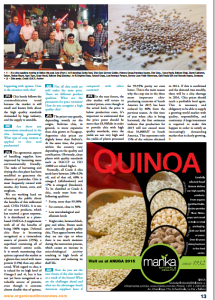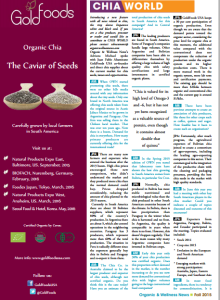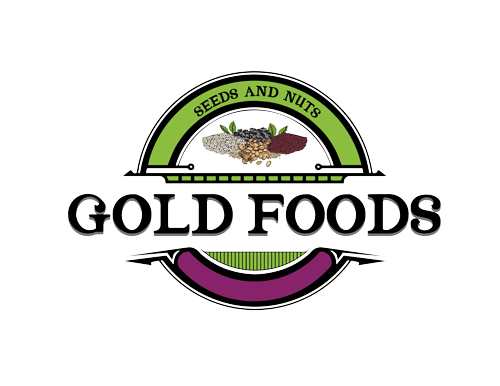
28 Sep Chia World: current market for chia seeds, issues and opportunities
Introducing a new feature with all news related to chia, the tiny slavia hispanica white and black seed. If you are a chia producer, processor or trader and would like to contribute to CHIA WORLD please contact wbeaumont@organicwellnessnews.com
Organic & Wellness News’s Adriana Michael spoke with Juan Pablo Altamirano GoldFoods USA co-founder and direct chia supplier about the current market for chia seeds, issues and opportunities.
Here you have the whole story pag 12-13, num. 42
AM: When OWN started promoting chia seeds, there were no other b2b media around with any information about the tiny seeds. Only one brand in North America was offering chia seeds taken from the original source in Acatic Jalisco Mexico to be grown in Argentina and Paraguay. One firm was selling them in the Chilean local market. That was over ten years ago. Now there is a boom. Demand for chia is everywhere. How many primary producers are currently offering chia for the international trade?
JPA: There are many new farmers and exporters who entered the business after the 2013 boom. High chia prices encouraged these new competitors, who didn’t understand the market and they produced more chia than the normal demand could buy. Prices dropped considerably, reducing the amount of chia planted in the 2015 season. Currently in South America there are about 10 Bolivian suppliers, which represent 80% of the country’s production. In Argentina there are about 5, which also control operations in the neighboring countries. Paraguay has 3 producers, which represent more than 60% of the total production. The situation in Peru is radically different since the exporters generally buy chia in Bolivia and Paraguay and re-export it from there.
AM: The Chia Co. in Australia claimed to be the largest producer and exporter of chia seeds, although not certified organic. Do you think this is the case today? Have you an estimate of the CHIA WORLD total production of chia seeds in South America for this campaign? And in Central America?
JPA: The leading producers are found in South America. Some of Paraguay’s companies handle large volumes. Other Argentine and Bolivian companies have been able to differentiate themselves by offering a large volume of high quality chia with safety certifications and large investments in certified organic plants.
“Chia is valued for its high level of Omega-3 and -6, but it has not yet been recognized as a valuable source of protein, even though it contains almost double that of quinoa”
AM: In the Spring 2015 edition of OWN you stated that laboratory tests have shown the best chia growing in South America comes from Bolivia, in particular Sta Cruz.
JPA: Normally, chia produced in Bolivia has more stable nutritional and microbiological value than the chia produced in other South American countries because of the climate. In Bolivia, there is less precipitation than Paraguay in the winter when chia is harvested and no frost. In Argentina, the quality is comparable in years when there is no frost. However, this doesn’t happen regularly. That is the main reason why many Argentine companies have invested in Bolivian crops.
AM: Early this year only 30% of your chia production was certified organic. Does this proportion reflect demand in the market, is the number increasing or do you see now more demand for conventional chia with higher volumes going to the large conventional food companies? 
JPA: GoldFoods USA keeps a 30 per cent participation of organic production. Even though we are aware that the demand points toward the organic sector, considering the price level for organic chia at this moment, the additional value compared with the conventional does not compensate the reduction of production under the organic system and its higher production costs. There is more manual work in the organic system, more lab tests and certification payments. The existing gap should be more than $2/kilo between organic and conventional chia and the current gap is around $1/kilo.
AM: There have been previous attempts to create an association of chia producers, like those for other crops such as coffee, quinoa and sugar. How feasible has it been to create such an organization?
JPA: Fortunately, after much progress, the agricultural exporters of Bolivian chia joined to create a consortium of agro-exporters, including the leading agro-exporting companies in this sector. Their common goal is the integration of the productive chain with the cleaning and packaging processes, providing the best chia seeds in the market with high quality standards.
AM: In June this year you had a meeting with other key South American players in the chia market Could you indicate a couple of topics discussed and outcome of this encounter?
JPA: Exporters from Argentina, Paraguay, Bolivia, and Ecuador participated in the meeting. Topics evaluated included: * Stock 2014 * Crop size 2015 * Evolution in the European and North American demand * Emerging markets with strong participation: Australia, Japan, Eastern Europe, and Southeast Asia
AM: In most food ingredients, there is a tendency for commoditization. It is happening with quinoa. How is the situation with chia?
JPA: Chia barely follows the commoditization trend because the market is still small and knows little about the high quality standards demanded by large industry, and the supply is unstable.
AM: Are there any innovations introduced in the chia farming, processing? What type of crop rotation is applied to chia seed production?
JPA: The agronomic aspects of handling supplies have improved by becoming more environmentally friendly. The tasks of harvesting and drying the chia plant has been modified to guarantee the absence of pesticides. Chia is most frequently rotated with sesame, dry beans, corn, and sorghum. We are working hard on educating the public about the benefits of this millennial seed. CHIA PEARL. It is one of our new products, which has received a great response. It is distributed as a plantbased OMEGA-3 supplement with all of the benefits of being 100% vegan. Defatted chia flour is becoming recognized as a tremendous source of protein (25%), a superfood containing all of the essential amino acids. It is worth mentioning that quinoa captured the market as a gluten-free cereal with more protein (14%) than any other cereal. With regard to chia, it is valued for its high level of Omega-3 and -6, but it has not yet been recognized as a valuable source of protein, even though it contains almost double that of quinoa.
AM: Not all chia seeds are sold under the same price. There are different product qualities. What are the parameters for price variation? How do you recognize a high quality chia?
JPA: The prices vary greatly, depending mostly on the origin. Bolivian chia, in general, is more expensive than chia grown in Paraguay. Argentine chia prices are slightly lower than Bolivia’s. At the same time, the prices within the country vary depending on the quality and certification. Obviously, clean plants with quality standards such as HACCP or ISO 22000 are valued higher. Normally, all Grade A chia seeds have between 28%-32% oil, and of that oil, 60% is omega-3 (alfalinolenic) and 17% is omega-6 (linolenic). To be classified as Grade A chia, seeds must have the following qualities: * Purity, more than 99.90% * Fat content, close to 30% * Low microbiological and aflatoxin levels * Bright color, between black, gray and white. Brown seeds aren’t normally good quality chia. They appear brown when they are not ripe or when there is too much moisture during the maturation process, which causes an increase in microbiological activity resulting in high levels of mycotoxins and reducing its shelf life.
AM: How do you see the near future of the chia market as a result of the boom? What are the challenges ahead and what are the advantages South American suppliers have if compared with other countries?
JPA: In the near future, the chia market will return to normal prices, even though at the actual level, the price is below production costs. It’s important to understand that the price point should be more than $3.50/kilo in order to provide chia with high quality standards, since the yields are not very high and the yields of plants processed for 99.95% purity are even lower. This is the main reason why the crop size in the three most important chiaproducing countries of South America for 2015 has been reduced by 80% from the previous season. At this time of year when chia is being harvested, the first estimates indicate that production for 2015 will not exceed more than 10,000MT in South America. This represents only 15% of the volume obtained in 2014. If this is confirmed and the demand rises steadily, there will be a chia shortage in 2016. Chia prices should reach a profitable level again. This is necessary and obligatory to be able to supply a growing world market with quality, responsibility, and continuity. A large investment is required to make this happen in order to satisfy an increasingly demanding market that is clearly growing.




